The 6 Septic Systems: Which One Is Right or Wrong for You?
 |
| comparing the 6 septic systems |
Introduction:
 |
| Conventional Gravity System |
When it comes to handling wastewater, septic systems reign as a top choice for homeowners residing beyond the reach of municipal sewer services. Think of a septic system as your very own mini sewage treatment facility, designed to treat and dispose of your home's wastewater right on your property. With a plethora of septic system options, each with its own unique perks and drawbacks, selecting the perfect fit for your land can be a perplexing endeavor. Nevertheless, it's crucial to ensure that the chosen system functions optimally based on your household requirements.
6 Septic Systems: Insights and Recommendations from Industry Veterans
Drawing on a combined experience of over 40 years, my partner Jeane and I have tackled a diverse range of situations and hurdles within the septic systems field. As skilled practitioners, we are passionate about sharing the invaluable knowledge we have accumulated over time with existing septic system owners and those considering new installations. This blog focuses on providing useful information and advice on six different septic systems, as well as guidance on their respective costs and other pertinent issues.
In this article, we'll look into the six most prevalent septic system types, weighing their pros and cons, and helping you pinpoint the ideal choice for your needs. Additionally, we'll glance at four lesser-known systems that could be worth considering, depending on your unique circumstances.
Conventional Gravity System
Pressure Distribution System
Aerobic Treatment Unit
Sand Filter System
Mound System
Drip Irrigation System
Constructed Wetland System
Recirculating Sand Filter System
Peat Moss System
Disinfection Systems
Each of these systems has its own set of benefits and limitations, and choosing the right system for your property depends on several factors. It's essential to consult with a licensed septic system installer or engineer to determine which system will work best for your specific needs.
1.Conventional Gravity System:
a) Septic Tank:
The septic tank, an expansive buried receptacle crafted from concrete, fiberglass, or plastic, is generally situated underground, in close proximity to the residence or structure it serves. Household wastewater meanders into the septic tank via the inlet pipe, where it lingers temporarily, permitting solids to plummet to the bottom while grease and oils ascend to the surface. Subsequently, the liquid wastewater, or effluent, is discharged into a distribution box. The dimensions of a septic tank hinge upon the home's number of bedrooms and the water consumption patterns of its occupants. A standard residential septic tank typically spans 1,000 to 1,500 gallons in size. For commercial or industrial purposes, heftier tanks are necessitated.
b) Distribution Box:
The distribution box is a small, concrete or plastic chamber that's located downstream of the septic tank. It's designed to evenly distribute the effluent from the septic tank to the drain field. The distribution box is connected to the septic tank outlet pipe and the drain field pipes.
c) Drain Field:
The drain field, also referred to as the leach field, encompasses a sequence of punctured pipes or chambers buried beneath the earth's surface. Effluent from the septic tank meanders into the distribution box and is uniformly dispersed throughout the drain field. This field is meticulously engineered to permit the effluent to gradually seep into the soil, where it undergoes natural filtration and treatment courtesy of bacteria and other microorganisms. The dimensions and design of the drain field hinge on multiple factors, such as the septic tank's size, the household's number of occupants, and the soil's type and quality. Generally, a residential drain field spans anywhere from 500 to 1,500 square feet.
Pros and Cons of Conventional Gravity System:
Like all septic systems, the conventional gravity system has its pros and cons. Here are some of the advantages:
Affordability: The conventional gravity system is one of the most affordable types of septic systems. It requires fewer components and less maintenance than other systems, which makes it a popular choice for residential applications.
Reliability: The conventional gravity system has a proven track record of reliability. When properly installed and maintained, it can provide years of trouble-free service.
Low Maintenance: The conventional gravity system requires minimal maintenance. The septic tank should be pumped every 3-5 years to remove solids and prevent backups, but other than that, there are no major maintenance requirements.
Environmentally Friendly: The conventional gravity system is an environmentally friendly option for wastewater treatment. The effluent is naturally filtered and treated by bacteria and other microorganisms in the soil, which helps to protect groundwater and surface water quality.
However, there are also some disadvantages to the conventional gravity system:
Limited Applicability: The conventional gravity system is not suitable for all properties. It requires a certain amount of space and soil quality to function properly. Properties with high groundwater levels, poor soil drainage, or steep slopes may not be suitable for this type of system.
Limited Capacity: The conventional gravity system has a limited capacity for handling wastewater. It's not suitable for properties with a large number of occupants or high water usage.
Maintenance Requirements: While the conventional gravity system requires minimal maintenance, it still requires regular pumping to prevent backups and maintain proper function. Failure to maintain the system can result in costly repairs and potential health hazards.
Odor Issues: The conventional gravity system can produce unpleasant odors if it's not properly maintained. This can be especially problematic for homes located in close proximity to other properties.
Environmental Concerns: While the conventional gravity system is an environmentally friendly option for wastewater treatment, it can still have an impact on local ecosystems if it's not properly maintained. Improperly treated wastewater can contaminate groundwater and surface water, which can harm aquatic life and human health.
How to Determine if Conventional Gravity System is Right for You:
The conventional gravity system is a popular choice for residential applications, but it's not suitable for all properties. Here are some factors to consider when determining if a conventional gravity system is right for you:
Soil Type and Quality: The conventional gravity system requires soil that's permeable and can absorb water easily. Properties with heavy clay soil or shallow soil depth may not be suitable for this type of system.
Groundwater Level: The conventional gravity system requires a certain amount of distance between the drain field and groundwater table. Properties with high groundwater levels may not be suitable for this type of system.
Lot Size and Topography: The conventional gravity system requires a certain amount of space for the drain field. Properties with limited space or steep slopes may not be suitable for this type of system.
Number of Occupants in the Home: The conventional gravity system has a limited capacity for handling wastewater. Homes with a large number of occupants or high water usage may require a larger septic tank or a different type of system.
Water Usage Habits: The conventional gravity system is designed to handle typical residential water usage habits. Homes with excessive water usage, such as those with multiple bathrooms, swimming pools, or irrigation systems, may require a larger septic tank or a different type of system.
Conclusion on a Conventional Gravity System:
The time-tested gravity septic system emerges as a dependable and budget-friendly alternative for residential wastewater management. Nevertheless, it's crucial to ponder soil type and quality, groundwater level, plot dimensions and topography, home occupancy, and water usage tendencies before committing to this system variant. Moreover, adequate system maintenance is vital to avert pricey repairs and possible health risks. Collaborating with a certified septic system installer or engineer can assist in discerning whether a conventional gravity system befits your property.
2.Pressure Distribution Septic System
The pressure distribution septic system, akin to the conventional gravity system, employs a pump to uniformly disseminate effluent throughout the drain field. This system is tailored to surmount the limitations of the conventional gravity system, such as inadequate soil drainage, elevated groundwater levels, or steep inclines. Here's the breakdown:
a) Septic Tank:
In a pressure distribution system, the septic tank resembles that of a conventional gravity system. It amasses and treats household wastewater, enabling solids to descend to the bottom and grease and oils to ascend to the top. The effluent is subsequently discharged into the pump tank.
The septic tank's size in a pressure distribution system hinges on the home's number of bedrooms and the water consumption habits of its occupants. A standard residential septic tank typically spans 1,000 to 1,500 gallons. For commercial or industrial applications, heftier tanks may be necessitated.
b) Pump Tank:
The pump tank, a petite concrete or plastic chamber situated downstream of the septic tank, houses a submersible pump engineered to uniformly distribute effluent from the septic tank to the drain field. The pump tank connects to the septic tank outlet pipe and the drain field pipes.
The pump within the pump tank is regulated by a float switch or a timer. As the effluent in the pump tank attains a specific level, the pump activates, propelling the effluent toward the drain field via a series of small-diameter pipes or tubing.
c) Drain Field:
The pressure distribution system's drain field mirrors that of a conventional gravity system, consisting of a sequence of punctured pipes or chambers buried underground. The effluent from the septic tank is uniformly distributed to the drain field through the small-diameter pipes or tubing. The drain field is designed to permit the effluent to gradually seep into the soil, where it undergoes natural filtration and treatment courtesy of bacteria and other microorganisms.
The dimensions and design of the drain field in a pressure distribution system hinge on multiple factors, such as the septic tank's size, the household's number of occupants, and the soil's type and quality. Generally, a residential drain field spans anywhere from 500 to 1,500 square feet.
Pros and Cons of Pressure Distribution System:
Like all septic systems, the pressure distribution system has its pros and cons. Here are some of the advantages:
Improved Drainage: The pressure distribution system is designed to overcome the limitations of the conventional gravity system, such as poor soil drainage, high groundwater levels, or steep slopes. The pump in the pump tank ensures that the effluent is evenly distributed throughout the drain field, which improves drainage and reduces the risk of backups.
Higher Capacity: The pressure distribution system can handle a higher volume of wastewater than the conventional gravity system. This makes it a good choice for homes with a large number of occupants or high water usage.
Lower Risk of Failure: The pressure distribution system is less likely to experience failures than the conventional gravity system. The even distribution of effluent throughout the drain field reduces the risk of clogs and backups.
Lower Odor Issues: The pressure distribution system is less likely to produce unpleasant odors than the conventional gravity system. The even distribution of effluent throughout the drain field reduces the risk of anaerobic bacteria growth, which can produce odors.
However, there are also some disadvantages to the pressure distribution system:
Higher Cost: The pressure distribution system is more expensive than the conventional gravity system. It requires a pump tank, a submersible pump, and small-diameter pipes or tubing, which increases the cost of installation.
Higher Maintenance Requirements: The pressure distribution system requires more maintenance than the conventional gravity system. The pump and control system must be inspected and maintained regularly to ensure proper function.
Energy Consumption: The pressure distribution system requires electricity to power the pump, which can increase energy consumption and utility bills.
Environmental Concerns: While the pressure distribution system is designed to improve drainage and reduce the risk of backups, it can still have an impact on local ecosystems if it's not properly maintained. Improperly treated wastewater can contaminate groundwater and surface water, which can harm aquatic life and human health.
How to Determine if Pressure Distribution System is Right for You:
The pressure distribution system is a good choice for properties with poor soil drainage, high groundwater levels, or steep slopes. Here are some factors to consider when determining if a pressure distribution system is right for you:
Soil Type and Quality: The pressure distribution system is designed to improve drainage in soils that have poor percolation rates. Properties with heavy clay soil or shallow soil depth may be suitable for this type of system.
Groundwater Level: The pressure distribution system can overcome high groundwater levels that may be problematic for the conventional gravity system. Properties with high groundwater levels may be suitable for this type of system.
Lot Size and Topography: The pressure distribution system requires a certain amount of space for the pump tank and small-diameter pipes or tubing. Properties with limited space or steep slopes may not be suitable for this type of system.
Number of Occupants in the Home: The pressure distribution system can handle a higher volume of wastewater than the conventional gravity system. Homes with a large number of occupants or high water usage may benefit from this type of system.
Water Usage Habits: The pressure distribution system is designed to handle typical residential water usage habits. Homes with excessive water usage, such as those with multiple bathrooms, swimming pools, or irrigation systems, may benefit from this type of system.
Conclusion on pressure distribution septic system:
Improved Drainage: The pressure distribution system is designed to overcome the limitations of the conventional gravity system, such as poor soil drainage, high groundwater levels, or steep slopes. The pump in the pump tank ensures that the effluent is evenly distributed throughout the drain field, which improves drainage and reduces the risk of backups.
Higher Capacity: The pressure distribution system can handle a higher volume of wastewater than the conventional gravity system. This makes it a good choice for homes with a large number of occupants or high water usage.
Lower Risk of Failure: The pressure distribution system is less likely to experience failures than the conventional gravity system. The even distribution of effluent throughout the drain field reduces the risk of clogs and backups.
Lower Odor Issues: The pressure distribution system is less likely to produce unpleasant odors than the conventional gravity system. The even distribution of effluent throughout the drain field reduces the risk of anaerobic bacteria growth, which can produce odors.
Higher Cost: The pressure distribution system is more expensive than the conventional gravity system. It requires a pump tank, a submersible pump, and small-diameter pipes or tubing, which increases the cost of installation.
Higher Maintenance Requirements: The pressure distribution system requires more maintenance than the conventional gravity system. The pump and control system must be inspected and maintained regularly to ensure proper function.
Energy Consumption: The pressure distribution system requires electricity to power the pump, which can increase energy consumption and utility bills.
Environmental Concerns: While the pressure distribution system is designed to improve drainage and reduce the risk of backups, it can still have an impact on local ecosystems if it's not properly maintained. Improperly treated wastewater can contaminate groundwater and surface water, which can harm aquatic life and human health.
Soil Type and Quality: The pressure distribution system is designed to improve drainage in soils that have poor percolation rates. Properties with heavy clay soil or shallow soil depth may be suitable for this type of system.
Groundwater Level: The pressure distribution system can overcome high groundwater levels that may be problematic for the conventional gravity system. Properties with high groundwater levels may be suitable for this type of system.
Lot Size and Topography: The pressure distribution system requires a certain amount of space for the pump tank and small-diameter pipes or tubing. Properties with limited space or steep slopes may not be suitable for this type of system.
Number of Occupants in the Home: The pressure distribution system can handle a higher volume of wastewater than the conventional gravity system. Homes with a large number of occupants or high water usage may benefit from this type of system.
Water Usage Habits: The pressure distribution system is designed to handle typical residential water usage habits. Homes with excessive water usage, such as those with multiple bathrooms, swimming pools, or irrigation systems, may benefit from this type of system.
The pressure distribution septic system is a reliable and effective option for properties with poor soil drainage, high groundwater levels, or steep slopes. While it requires more maintenance and has higher installation costs than the conventional gravity system, it can provide improved drainage and higher capacity for handling wastewater. Consulting with a licensed septic system installer or engineer can help you determine if a pressure distribution system is right for your property.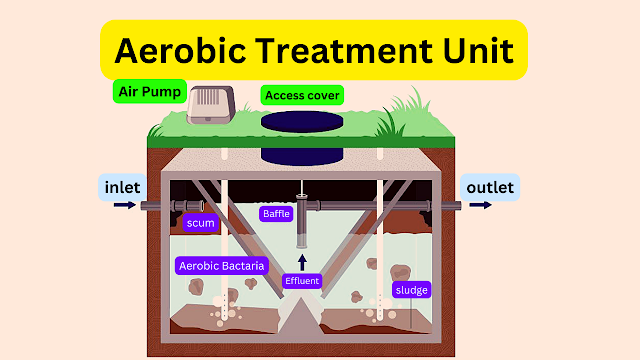
Aerobic Treatment Unit
Aerobic Treatment Unit
I reckon I oughta share some knowledge about these Aerobic Treatment Units (ATUs). They sure are nifty septic systems that use aerobic bacteria to break down organic matter in our wastewater. Let me walk y'all through how it works:
a) Pretreatment Tank:
First off, we got ourselves a pretreatment tank that collects and holds the wastewater from your home. It's sorta like your regular septic tank, but this one's got an aeration system to help those aerobic bacteria grow by giving' 'em the oxygen they need.
b) Aeration Chamber:
Next up, we got the aeration chamber, home to our aerobic bacteria friends. Just like the pretreatment tank, it's got an aeration system that keeps oxygen flowing' so those little critters can feast on the organic matter, producing carbon dioxide, water, and even more bacteria.
c) Clarification Chamber:
Movin' on, the wastewater goes to the clarification chamber, where we separate the leftover organic matter and bacteria from the now-treated effluent. This chamber's got a settlin' system that lets the solids sink to the bottom while the clear effluent rises to the top.
d) Disinfection:
Finally, we give that effluent a good cleanin' with some chlorine or another disinfectant to kill any remainin' bacteria and viruses. That way, it's safe for release back into the environment.
Now, nothin's perfect, so let's talk about the pros and cons of these ATUs:

Pros and Cons of Aerobic Treatment Units:
Advanced Treatment: These ATUs are top-notch at treating wastewater, giving' us cleaner effluent that's safer for the environment.
Lower Environmental Impact: With aerobic bacteria and disinfectants doin' their job, the risk of pollution and contamination is reduced.
Flexible Installation: You can put these ATUs in all sorts of places, like properties with poor soil drainage, high groundwater levels, or steep slopes. Handy, huh?
Lower Maintenance Requirements: Compared to other septic systems, ATUs don't need as much fussing' over. Just keep an eye on the aeration and settling' systems, and you're good to go.
Cons:
Higher Cost: ATUs can be pricier due to their aeration and clarification chambers, as well as disinfection equipment.
Higher Energy Consumption: Keep in mind that the aeration system needs electricity, which can raise your utility bills.
Regular Inspections Required: Make sure you inspect your ATU regularly to keep it working' smoothly, or you might end up with costly repairs and health hazards.
Odor Issues: If not maintained properly, ATUs can get a bit stinky from the aeration system introducing air into the pretreatment tank.
And there you have it! That's the lowdown on Aerobic Treatment Units. As always, happy pluming'!
How to Determine if Aerobic Treatment Unit is Right for You:
The aerobic treatment unit is a good choice for properties that require advanced treatment of wastewater, have poor soil drainage, high groundwater levels, or steep slopes. Here are some factors to consider when determining if an aerobic treatment unit is right for you:
Soil Type and Quality: The aerobic treatment unit requires soil that's permeable and can absorb water easily. Properties with heavy clay soil or shallow soil depth may not be suitable for this type of system.
Groundwater Level: The aerobic treatment unit requires a certain amount of distance between the discharge point and groundwater table. Properties with high groundwater levels may not be suitable for this type of system.
Lot Size and Topography: The aerobic treatment unit requires a certain amount of space for the aeration chamber and clarification chamber. Properties with limited space or steep slopes may not be suitable for this type of system.
Water Usage Habits: The aerobic treatment unit is designed to handle typical residential water usage habits. Homes with excessive water usage, such as those with multiple bathrooms, swimming pools, or irrigation systems, may require a larger system or a different type of system.
Required Permits: The installation of an aerobic treatment unit may require permits and inspections from local regulatory agencies. Consulting with a licensed septic system installer or engineer can help you determine the permitting requirements in your area.
Conclusion Aerobic treatment unit:
Aerobic Septic System Overview
The aerobic treatment unit is a reliable and effective option for properties that require advanced treatment of wastewater. While it's more expensive and requires more maintenance than other types of septic systems, it can provide a higher quality effluent and has a lower environmental impact. Consulting with a licensed septic system installer or engineer can help you determine if an aerobic treatment unit is right for your property. Proper maintenance is key to ensuring the longevity and effectiveness of the system. Regular inspections and cleaning of the aeration and clarification chambers are necessary to prevent costly repairs and potential health hazards.

The sand filter system

The sand filter system
a) Pretreatment Tank:b) Sand Filter:
c) Drain Field:
Pros and Cons of Sand Filter System:
However, there are also some disadvantages to the sand filter system:
How to Determine if Sand Filter System is Right for You:
Conclusion Sand Filter System:
 |
| Mound System |
It's time to share some knowledge about these sand filter systems, a mighty fine type of septic system that uses layers of sand and gravel to filter and treat wastewater. These systems produce a higher quality effluent than other septic systems, and here's how they work:
First off, we got ourselves a pretreatment tank that collects and holds wastewater from your home. It's sorta like your regular septic tank, but this one's made to remove larger solids and grease before the effluent heads to the sand filter.
Next, the pretreated effluent moseys on over to the sand filter, which has a layer of sand and a layer of gravel. The effluent is spread evenly over the top of the sand layer and trickles down through the sand and gravel layers, gettin' filtered and treated along the way.
The sand and gravel layers act as a barrier that filters out fine particles and bacteria from the wastewater. The sand filter's got a distribution network that makes sure the effluent is spread evenly over the sand layer.
After passin' through the sand filter, the treated effluent is discharged to the drain field. The drain field's a lot like the one in a conventional system, but it gets a higher quality effluent than other types of systems. The drain field allows the effluent to seep slowly into the soil, where it's naturally filtered and treated by bacteria and other microorganisms.
Like all septic systems, the sand filter system has its pros and cons. Here are some of the advantages:
Advanced Treatment: The sand filter system provides advanced treatment of wastewater, producing a higher quality effluent than other types of septic systems. The treated effluent is cleaner and safer for release into the environment.
Lower Environmental Impact: The sand filter system has a lower environmental impact than other types of septic systems. The effluent is filtered and treated naturally by the sand and gravel layers, which reduces the risk of contamination and pollution.
Flexible Installation: The sand filter system can be installed in a variety of locations, including properties with poor soil drainage, high groundwater levels, or steep slopes. This makes it a good choice for properties that may not be suitable for other types of septic systems.
Low Energy Consumption: The sand filter system requires no electricity to operate, which results in lower energy consumption and utility bills.
Higher Cost: The sand filter system is more expensive than other types of septic systems. It requires a sand filter bed and a distribution network, which increases the cost of installation.
Regular Maintenance Requirements: The sand filter system requires regular maintenance to ensure that the sand and gravel layers are functioning properly. The sand layer must be periodically replaced, and the distribution network must be inspected and cleaned.
Odor Issues: The sand filter system can produce unpleasant odors if it's not properly maintained. The sand layer requires regular replacement to prevent clogging and odor issues.
The sand filter system is a good choice for properties that require advanced treatment of wastewater and have poor soil drainage, high groundwater levels, or steep slopes. Here are some factors to consider when determining if a sand filter system is right for you:
Soil Type and Quality: The sand filter system requires soil that's permeable and can absorb water easily. Properties with heavy clay soil or shallow soil depth may not be suitable for this type of system.
4.Groundwater Level: The sand filter system requires a certain amount of distance between the discharge point and groundwater table. Properties with high groundwater levels may not be suitable for this type of system.
5.Lot Size and Topography: The sand filter system requires a certain amount of space for the sand filter bed and distribution network. Properties with limited space or steep slopes may not be suitable for this type of system.
6.Water Usage Habits: The sand filter system is designed to handle typical residential water usage habits. Homes with excessive water usage, such as those with multiple bathrooms, swimming pools, or irrigation systems, may require a larger system or a different type of system.
7.Required Permits: The installation of a sand filter system may require permits and inspections from local regulatory agencies. Consulting with a licensed septic system installer or engineer can help you determine the permitting requirements in your area.
The sand filter system is a reliable and effective option for properties that require advanced treatment of wastewater. While it's more expensive and requires more maintenance than other types of septic systems, it can provide a higher quality effluent and has a lower environmental impact. Consulting with a licensed septic system installer or engineer can help you determine if a sand filter system is right for your property. Proper maintenance is key to ensuring the longevity and effectiveness of the system. Regular inspections, cleaning, and replacement of the sand layer are necessary to prevent costly repairs and potential health hazards.
Mound Septic SystemMound System
The mound system is a type of septic system that's designed for properties with poor soil drainage or high groundwater levels. This system uses layers of sand and gravel to create an elevated mound that provides a suitable soil environment for the treatment of wastewater. Here's how it works:
a) Pretreatment Tank:
The mound system begins with a pretreatment tank, which collects and holds wastewater from the home. The pretreatment tank is similar to the septic tank in a conventional system, but it's designed to remove larger solids and grease before the effluent enters the mound.
b) Mound:
The pretreated effluent is then directed to the mound, which consists of a layer of sand and gravel that's raised above the natural soil surface. The effluent is distributed evenly over the top of the sand layer, where it percolates down through the sand and gravel layers, being filtered and treated as it goes.
The sand and gravel layers provide a physical barrier that filters out fine particles and bacteria from the wastewater. The mound is typically constructed with a distribution network that evenly distributes the effluent over the sand layer.
c) Drain Field:
After leaving the mound, the treated effluent is discharged to the drain field. The drain field is similar to the one in a conventional system, but it receives a higher quality effluent than other types of systems. The drain field allows the effluent to seep slowly into the soil, where it's naturally filtered and treated by bacteria and other microorganisms.
Pros and Cons of Mound System:
Like all septic systems, the mound system has its pros and cons. Here are some of the advantages:
Suitable for Poor Soil Drainage: The mound system is a good choice for properties with poor soil drainage or high groundwater levels. The elevated mound provides a suitable soil environment for the treatment of wastewater.
Flexible Installation: The mound system can be installed in a variety of locations, including properties with limited space or steep slopes. This makes it a good choice for properties that may not be suitable for other types of septic systems.
Lower Environmental Impact: The mound system has a lower environmental impact than other types of septic systems. The effluent is filtered and treated naturally by the sand and gravel layers, which reduces the risk of contamination and pollution.
Lower Maintenance Requirements: The mound system requires less maintenance than other types of septic systems. The sand layer must be periodically replaced, but there are no major maintenance requirements.
However, there are also some disadvantages to the mound system:
Higher Cost: The mound system is more expensive than other types of septic systems. It requires a sand and gravel mound, a distribution network, and a larger drain field, which increases the cost of installation.
Odor Issues: The mound system can produce unpleasant odors if it's not properly maintained. The sand layer requires regular replacement to prevent clogging and odor issues.
How to Determine if Mound System is Right for You:
The mound system is a good choice for properties with poor soil drainage or high groundwater levels. Here are some factors to consider when determining if a mound system is right for you:
Soil Type and Quality: The mound system requires soil that's permeable and can absorb water easily. Properties with heavy clay soil or shallow soil depth may not be suitable for this type of system.
Groundwater Level: The mound system requires a certain amount of distance between the discharge point and groundwater table. Properties with high groundwater levels may be suitable for this type of system.
Lot Size and Topography: The mound system requires a certain amount of space for the sand and gravel mound and distribution network. Properties with limited space or steep slopes may not be suitable for this type of system.
Water Usage Habits: The mound system is designed to handle typical residential water usage habits. Homes with excessive water usage, such as those with multiple bathrooms, swimming pools, or irrigation systems, may require a larger system or a different type of system.
Required Permits: The installation of a mound system may require permits and inspections from local regulatory agencies. Consulting with a licensed septic system installer or engineer can help you determine the permitting requirements in your area.
Conclusion Mound System:
The mound system is a reliable and effective option for properties with poor soil drainage or high groundwater levels. While it's more expensive than other types of septic systems, it can provide a higher quality effluent and has a lower environmental impact. Consulting with a licensed septic system installer or engineer can help you determine if a mound system is right for your property. Proper maintenance is key to ensuring the longevity and effectiveness of the system. Regular inspections, cleaning, and replacement of the sand layer are necessary to prevent costly repairs and potential health hazards.
The drip irrigation system
The drip irrigation system is a type of septic system that uses a network of pipes and emitters to distribute treated wastewater to a subsurface drip field. This system is designed to provide advanced treatment of wastewater. Producing a higher quality effluent than other types of septic systems heres how it works:
a) Pretreatment Tank:
The drip irrigation system begins with a pretreatment tank. This collects and holds wastewater from the home. The pretreatment tank is similar to the septic tank in a conventional system. It's designed to remove larger solids and grease before the effluent enters the drip irrigation system.
b) Treatment Unit:
The pretreated effluent is then directed to the treatment unit and this provides advanced treatment of the wastewater.
Advanced Treatment: The sand filter system provides advanced treatment of wastewater, producing a higher quality effluent than other types of septic systems. The treated effluent is cleaner and safer for release into the environment.
Lower Environmental Impact: The sand filter system has a lower environmental impact than other types of septic systems. The effluent is filtered and treated naturally by the sand and gravel layers, which reduces the risk of contamination and pollution.
Flexible Installation: The sand filter system can be installed in a variety of locations, including properties with poor soil drainage, high groundwater levels, or steep slopes. This makes it a good choice for properties that may not be suitable for other types of septic systems.
Low Energy Consumption: The sand filter system requires no electricity to operate, which results in lower energy consumption and utility bills.
Higher Cost: The sand filter system is more expensive than other types of septic systems. It requires a sand filter bed and a distribution network, which increases the cost of installation.
Regular Maintenance Requirements: The sand filter system requires regular maintenance to ensure that the sand and gravel layers are functioning properly. The sand layer must be periodically replaced, and the distribution network must be inspected and cleaned.
Odor Issues: The sand filter system can produce unpleasant odors if it's not properly maintained. The sand layer requires regular replacement to prevent clogging and odor issues.
This treatment unit will consist of several components such as the aeration chambers, media filters, and often disinfection units, depending on the level of the treatment required.
The treatment unit uses a combination of physical, biological, and chemical processes to remove the pollutants and the pathogens from the wastewater. Then the treated effluent is then directed to the pump chamber, which then pumps the effluent through a network of pipes and emitters to the subsurface drip field.
c) Subsurface Drip Field:
The subsurface drip field is a network of pipes and emitters that distribute the treated effluent evenly over a designated area.
The emitters release small amounts of effluent directly into the soil, where it's naturally filtered and treated by bacteria and other microorganisms.
Pros and Cons of Drip Irrigation System:
Like all septic systems, the drip irrigation system has its pros and cons. Here are some of the advantages:
Advanced Treatment:
The drip irrigation system provides advanced treatment of wastewater, producing a higher quality effluent than other types of septic systems.
The treated effluent is cleaner and safer for release into the environment.
Lower Environmental Impact:
The drip irrigation system has a lower environmental impact than other types of septic systems. The effluent is filtered and treated naturally by the soil and microorganisms, which reduces the risk of contamination and pollution.
Flexible Installation:
The drip irrigation system can be installed in a variety of locations, including properties with poor soil drainage, high groundwater levels, or steep slopes. This makes it a good choice for properties that may not be suitable for other types of septic systems.
Low Energy Consumption:
The drip irrigation system requires minimal electricity to operate, which results in lower energy consumption and utility bills.
However, there are also some disadvantages to the drip irrigation system:
Higher Cost:
The drip irrigation system is more expensive than other types of septic systems. It requires a treatment unit, a pump chamber, and a subsurface drip field, which increases the cost of installation.
Regular Maintenance Requirements:
The drip irrigation system requires regular maintenance to ensure that the treatment unit and subsurface drip field are functioning properly. The emitters and pipes must be periodically inspected and cleaned.
How to Determine if Drip Irrigation System is Right for You:
The drip irrigation system is a good choice for properties that require advanced treatment of wastewater and have poor soil drainage, high groundwater levels, or steep slopes.
Here are some factors to consider when determining if a drip irrigation system is right for you:
Soil Type and Quality: The drip irrigation system requires soil that's permeable and can absorb water easily. Properties with heavy clay soil or shallow soil depth may not be suitable for this type of system.
Groundwater Level: The drip irrigation system requires a certain amount of distance between the discharge point and groundwater table. Properties with high groundwater levels may not be suitable for this type of system.
Lot Size and Topography: The drip irrigation system requires a certain amount of space for the treatment unit, pump chamber, and subsurface drip field. Properties with limited space or steep slopes may not be suitable for this type of system.
Water Usage Habits: The drip irrigation system is designed to handle typical residential water usage habits. Homes with excessive water usage, such as those with multiple bathrooms, swimming pools, or irrigation systems, may require a larger system or a different type of system.
Required Permits: The installation of a drip irrigation system may require permits and inspections from local regulatory agencies. Consulting with a licensed septic system installer or engineer can help you determine the permitting requirements in your area.
Conclusion drip irrigation system:
The drip irrigation system is a reliable and effective option for properties that require advanced treatment of wastewater.
While it's more expensive than other types of septic systems, it can provide a higher quality effluent and has a lower environmental impact. Consulting with a licensed septic system installer or engineer can help you determine if a drip irrigation system is right for your property.
Proper maintenance is key to ensuring the longevity and effectiveness of the system. Regular inspections, cleaning, and replacement of the emitters and pipes are necessary to prevent costly repairs and potential health hazards.
drip irrigation systemOther types of septic systems:
There are several other types of septic systems and it very much depends on the situation or locations where the septic system is to be used .
Here are a few additional systems:
Constructed Wetland System: This system uses ( hint in the name)a constructed wetland area to naturally filter and treat wastewater. The wetland is filled with plants and bacteria that break down pollutants and pathogens in the effluent itself. This type of system is often used in the most rural of areas or properties that have large lots.

confused septic tank
Recirculating Sand Filter System:
This system surprisingly uses a sand filter this is periodically backwashed to redistribute and oxygenate the sand itself.
The effluent is distributed over the sand filter, then it is filtered and treated before being discharged on to a drain field.
Peat Moss System:
This system uses a layer of peat moss to filter and then treat the wastewater. With the effluent distributed over the peat moss and then this is where it is then filtered and treated by bacteria and other microorganisms.
This type of system is often best used in areas where there is poor soil drainage or a limited space available for a septic tank system.

Disinfection Systems:
These systems are designed to disinfect the effluent before it's released into the environment. The Disinfection can be achieved through various methods. For example chlorine, ultraviolet light, or ozone. The disinfection systems are often used together with other types of septic systems to provide a much higher level of treatment. It's important to note that the type of septic system that's right for a property. It depends on a variety of factors, including soil type, lot size, topography, and water usage habits.
Consulting with a licensed septic system installer or engineer can help you determine the best system for your property.
It's important to note that the type of septic system that's right for a property depends on a variety of factors including soil type, topography, and water usage habits.Consulting with a licensed septic system installer/engineer can help you determine the best system for your property.
Overall Summary The 6 Septic Systems: Which One Is Right or Wrong for You?
.png) |
| Jeane and Michael Sadler-The Septic Tankers |
.jpg)

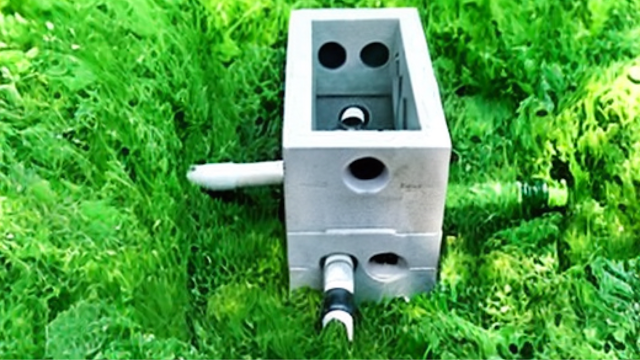

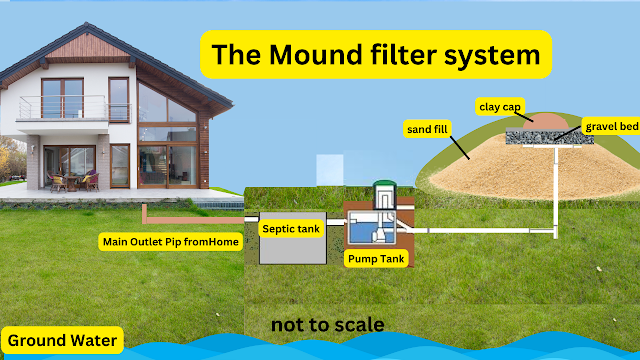
.png)

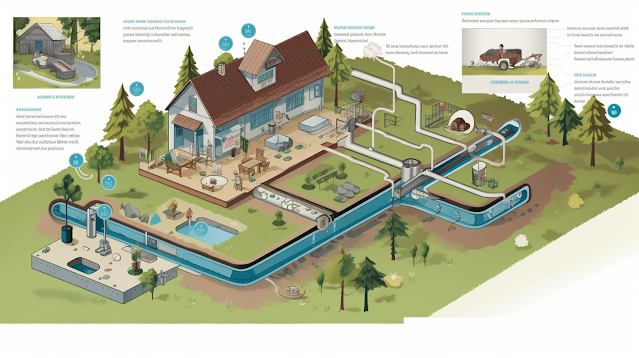
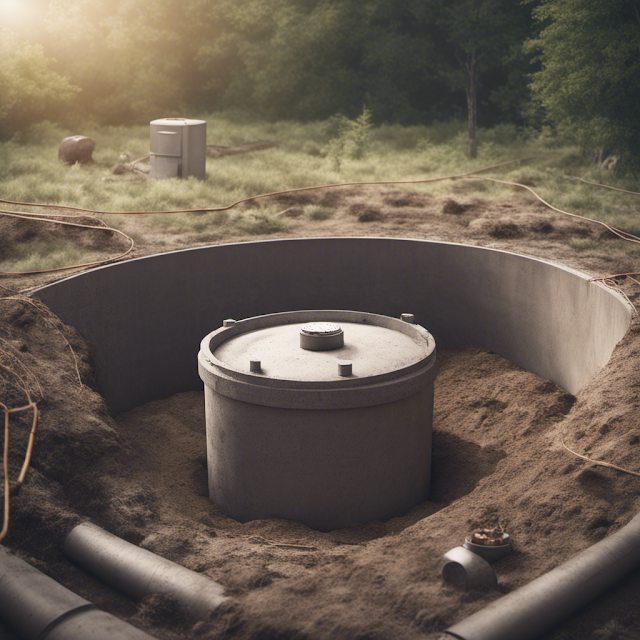
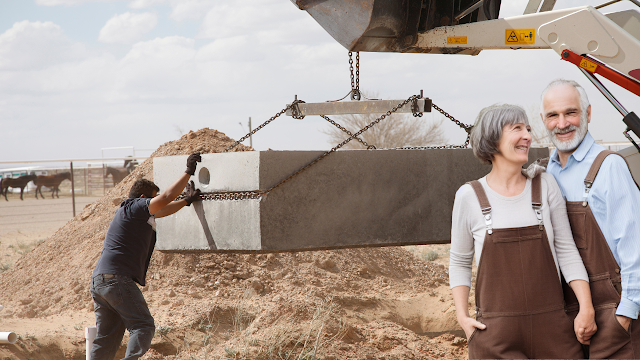


Comments
Post a Comment